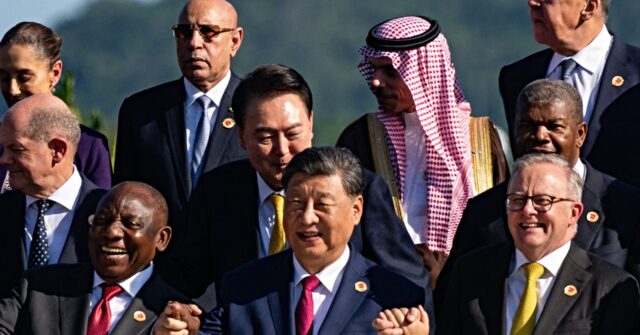As President Joe Biden approaches the end of his term with only 62 days left in office, his recent absence from critical global events raises questions about his engagement and focus. At the final Group of 20 (G20) summit, held in Rio de Janeiro, Biden missed the traditional group photo of world leaders—a significant moment meant to symbolize global unity and cooperation. Instead, Biden, who is 81 years old, arrived late with Canadian Prime Minister Justin Trudeau, prompting officials to attribute his absence to “logistical issues.” This incident has generated media scrutiny, particularly regarding Biden’s effectiveness and visibility on the international stage as he prepares to leave office.
During the summit, the spotlight shifted to other leaders, most notably Chinese President Xi Jinping, who stood at the forefront for the photograph. Meanwhile, Russian Foreign Minister Sergey Lavrov was relegated to a more obscured position in the back row. The late arrival of Biden and Trudeau is noteworthy, as both leaders appeared to be bewildered upon realizing they had missed the official photo opportunity, reflecting a possible lack of coordination or awareness on their part. The media’s portrayal of this scenario underscores the broader narrative about Biden’s lapses in attentiveness, questioning whether these moments are indicative of a more significant disengagement as his presidency winds down.
Prior to the G20 summit, Biden attracted media attention for another puzzling incident during his speech on climate change at the COP29 summit in Brazil. After addressing attendees, he seemed to stray off alone into the Amazon rainforest, further emphasizing perceptions of a president who might not be fully engaged with his surroundings. While the nature of his action could be interpreted as a simple misstep, it adds to a trend of uncertainty surrounding his leadership, especially in comparison to other high-profile figures at the summit. Such instances raise concerns about Biden’s ability to effectively navigate complex international relationships and crises.
In light of these events, U.S. officials have provided explanations for Biden’s absence from the group photo, suggesting that he did not wish to be seen alongside Lavrov due to the Russian foreign minister’s controversial presence. This concern was compounded by the absence of Vladimir Putin, who is facing an international arrest warrant related to the conflicts in Ukraine. The absence of key leaders like Putin, combined with Biden’s noticeable lapses, adds an element of tension to the diplomatic fabric at the summit, underlining the complexities and challenges of current global politics.
The G20 summit, meant to foster collaboration among the world’s leading economies, found itself overshadowed by these moments of disarray and confusion. Critics of Biden argue that such slip-ups undermine the United States’ position as a leader in global affairs and suggest a need for a more robust approach to diplomacy as the world grapples with pressing issues like climate change, conflict, and economic instability. The optics of first appearances at international gatherings carry weight, and Biden’s failure to participate fully raises serious questions about U.S. leadership and influence moving forward.
As Biden’s presidency nears its conclusion, the implications of these incidents extend beyond mere photo opportunities. They reflect an underlying sentiment about the state of U.S. leadership in an increasingly multipolar world, where other nations are vying for assertiveness and influence on the global stage. The future of U.S. international relations might depend heavily on how Biden addresses these challenges in his remaining days in office. Achieving meaningful engagement with both allies and adversaries is critical to ensuring the continuity and resilience of U.S. diplomatic efforts, making it essential for Biden to demonstrate a renewed commitment to global cooperation even as he prepares to hand over the reins to his successor.

